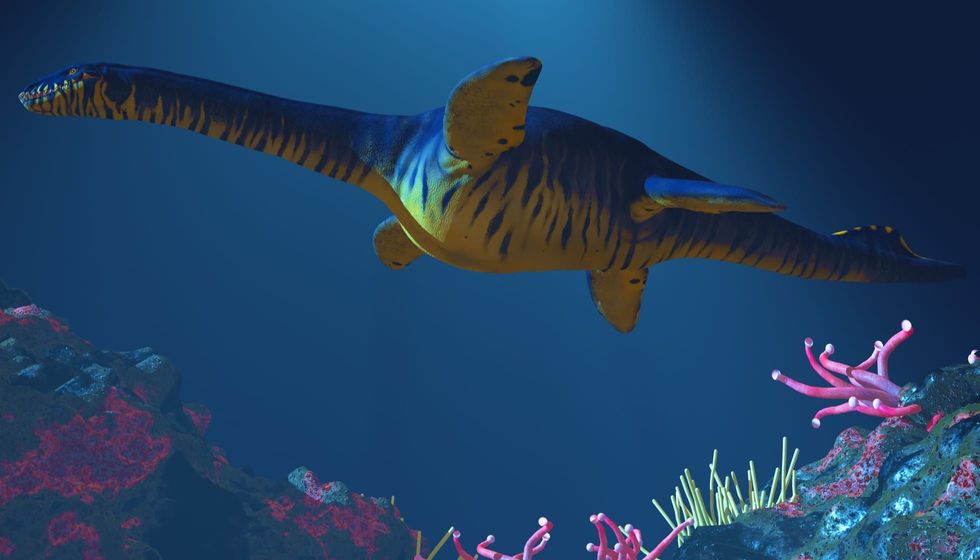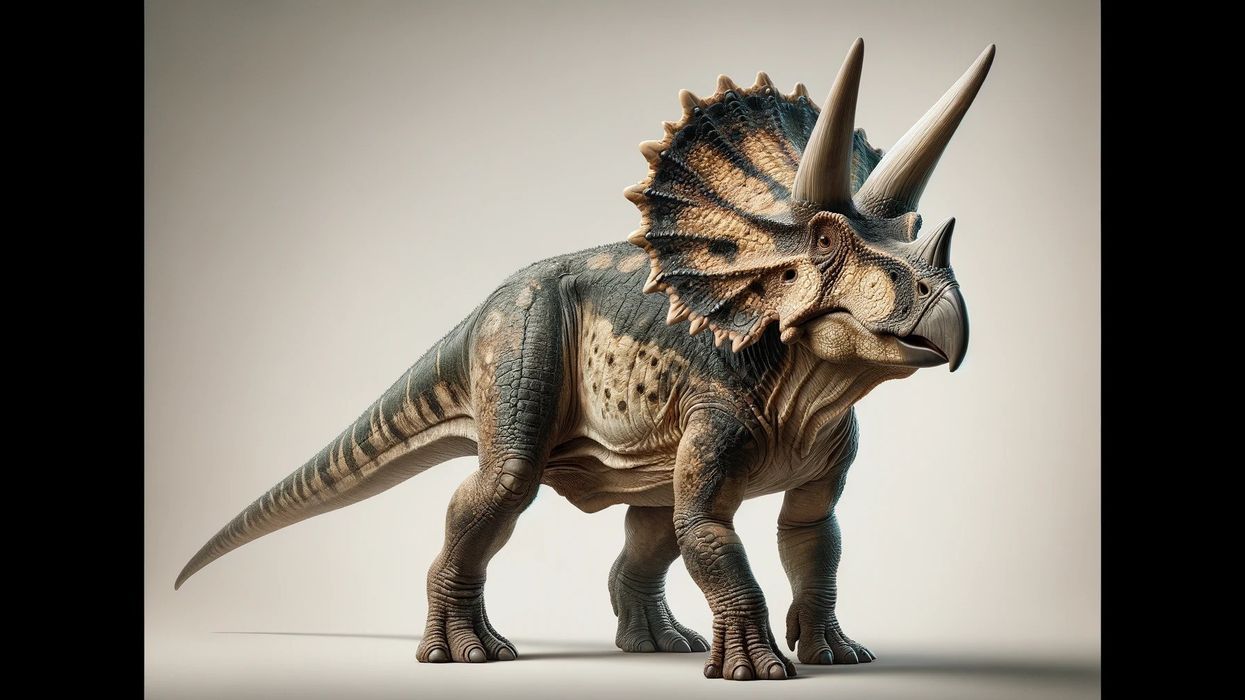Cryptoclidus eurymerus lived in South America and North America and also France, Russia and England. Its fossils have been found in various countries. The plesiosaur eurymerus was originally described as a hindlimb-less animal.
Cryptoclidus is a genus that refers to the hidden collarbone. It's located in the shoulder girdle. Cryptoclidus has a robust head and teeth, and it seemed to have developed a taste for soft-bodied prey. Its nasal openings are well-suited to detecting chemical traces and odors in the water.
Cryptoclidus was not a complete marine creature. It spent most of its time on land. Also, it probably didn't have time to feed.
An interesting cryptoclidus fact is that they had a seal-like body type. They were small soft bodied animals that existed 66 millions years ago.
They belonged to the middle Jurassic age. The diet of small soft bodied animal consisted of small fish, and meat as they had great strong teeth and were carnivores.
It was able to carry itself on land using its body plan. Critics of the plesiosaurs hypothesis also argued that air-breathing animals could not survive in cold lakes. The monster is also believed to have been formed 10,000 years ago.
In 2003, a group of tourists discovered fossilized vertebrae of this animal on the shores of Scotland's Loch Ness. It was later confirmed that the creatures were not planted.
For more relatable content, check out these monitor lizard facts and smooth green snake facts for kids.
Cryptoclidus Interesting Facts
What type of animal is a cryptoclidus?
Cryptoclidus is an animal which is a reptile. Some other types of reptiles are rattlesnake and worm snake.
What class of animal does a cryptoclidus belong to?
The cryptoclidus belongs to the Sauropsida class of animal.
How many cryptoclidus are there in the world?
This animal is extinct.
Where does a cryptoclidus live?
They lived in marine environments in seas and oceans as per the researches made through their fossils.
What is a cryptoclidus's habitat?
Cryptoclidus eurymerus lived in South America and North America and also France, Russia and England. Its fossils have been found in various countries.
Who do cryptoclidus live with?
The cryptoclidus lives along with its group or pack.
How long does a cryptoclidus live?
The estimates of the life span of the cryptoclidus eurymerus is unknown since they existed some millions of years ago.
How do they reproduce?
Studies made with the cryptoclidus reproduction made us widely believe that plesiosaurs were capable of reproduction. This conclusion coincides with the discovery of a fossil that was viviparous.
Evidence for this claim is based on the discovery of plesiosaurs that practiced viviparity. Also, the preserved embryos of the nothosaurosaurus lari indicate that this animal behaved similarly. There is also no direct evidence that the cryptoclidus had parents or social living arrangements.
However, research says there are some hints that these animals might have lived together in shallow coastal waters. Other animals that give birth to large babies are usually cared for by extended families.
Paleontologist Kevin O’Keefe of the University of Massachusetts says that the discovery of a large, single fetus through fossils was a surprise. The fact that similar embryos has been found in plesiosaurs was first claimed by Harry Govier Seeley. It was estimated that females gave birth to a child that measured about 13.1 ft (4 m) long.
What is their conservation status?
The C. eurymerus is currently extinct. In 1977, the discovery of a floating body with a long neck and protruding flippers caught the attention of Japanese scientists.
Although it was initially believed that the animal was a basking shark, it was later concluded that it was a cryptoclidus. Although the extinction of plesiosaurs was not considered a serious scientific issue, their sightings have sparked interest among these strange creatures.
Cryptoclidus Fun Facts
What do cryptoclidus look like?
Major groups of plesiosaurs are distinguished by their head and neck size. Some of these include the cryptoclididae, the elasmosauridae, and the pliosauridae.
The classification of these animals can be made from the fact that they had a long neck and may have been bottom-feeders in shallow waters. The typical plesiosaur has a broad body and a short tail. It retained its two pairs of clawed limbs.
These animals had four paddle-shaped flippers. It's believed that they used these limbs to propel themselves through the water by performing various movements. They did not have a tail fin.
Cryptoclidus was an aquatic reptile that had flexible and curved teeth and a large cryptoclidus skull. They do not have legs or feet, since they mostly live underwater, which is why they have developed fin like flaps to help them swim.

*Please note that this is an image of a Xixia Dinosaur, not a Cryptoclidus specifically. If you have an image of a Cryptoclidus, then please let us know at hello@kidadl.com.
How cute are they?
Cryptoclidus was a huge animal that belonged to middle Jurassic age and is no longer found, but their fossil looks dangerous displayed in the museum.
How do they communicate?
It is unknown as to how they communicate as they are extinct species. However, it is known that the entire Cryptoclidus genus from the middle Jurassic was partially aquatic. Therefore, they may use different communication gestures, like that of fish underwater.
How big is a cryptoclidus?
The cryptoclidus size of the body was about 78.74 in (200 cm) tall and 315 in (800 cm) long, but they are smaller than fin whale.
How fast can a cryptoclidus move?
The aquatic animals of genus cryptoclidus would swim in the oceans or the marine body using their flippers and feet, fast enough to catch its prey with help of its teeth. The flippers and feet help them move faster when in need.
How much does a cryptoclidus weigh?
The cryptoclidus weighs about 17637 lb (8000 kg).
What are the male and female names of the species?
Cryptoclidus was named cryptoclidus eurymerus scientifically. They do not have separate names for male and female.
What would you call a baby cryptoclidus?
The baby cryptoclidus can be called the fish cryptoclidus and the fish cryptoclidus is given birth directly like the mammals in the marine environment.
What do they eat?
The cryptoclidus diet consists of small soft bodied animals, and mainly includes small fish and squids. Since these small fish can easily be delivered and caught by their teeth. They detect their prey by chemical traces. Their teeth are narrow but sharp and quite helpful to catch the prey.
Are they poisonous?
No, all of the species of the C. eurymerus were non-poisonous.
Would they make a good pet?
The cryptoclidus eurymerus cannot be a pet, since they are huge and extinct.
Did you know...
Cryptoclidus species was initially described as Plesiosaurus by Phillips in 1871, it was mistaken or misidentified by him. The plesiosaur eurymerus was originally described as a hindlimb-less species by him. And later cryptoclidus was named by him.
One of the interesting cryptoclidus facts was that these species had peculiar nasal openings just like the terrestrial animals for the respiration.
What are cryptoclidus related to?
Plesiosaurs were large marine reptiles that did not have living relatives. They had long tails and broad bodies.
They resided in the Western Interior Seaway during the Cretaceous period. A study conducted by paleontologists Luis Chiappe and John O’Keefe suggested that some Cryptoclidus gave up to 40% of their body length to give birth to live young. The new study focused on the development of bone in plesiosaurs by taking samples from their mothers and babies.
These are related to the plesiosaur according to the head and teeth. The head and teeth of the fossils confirm the common characteristics.
When and why did cryptoclidus go extinct?
These soft bodied animals went extinct due the catastrophe and lack of food, as the diet of small soft mainly consists of fish and meat.
Here at Kidadl, we have carefully created lots of interesting family-friendly animal facts for everyone to discover! For more relatable content, check out these Burmese python facts and coral snake facts pages.
You can even occupy yourself at home by coloring in one of our free printable marine reptile coloring pages.









